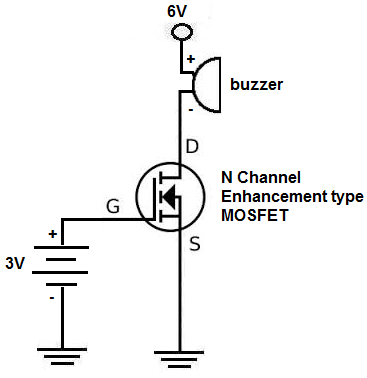How to Build an N-Channel MOSFET Switch Circuit

In this project, we will go over how to connect an N-Channel MOSFET to a circuit for it to function as an electronic switch.
The type of N-Channel MOSFET we will use is the enhancement-type MOSFET, the most commonly used type of MOSFET.
MOSFETs, like BJTs, can function as electronic switches. Although unlike BJTs, MOSFETs are turned on, not by current, but by voltage.
MOSFETs are voltage-controlled devices. This means that a voltage applied to the gate controls whether the transistor switches on or off. When an N-channel (enhancement-type) MOSFET has no voltage at its gate, it is OFF and no current conducts across from drain to source; thus, the load connected to the MOSFET will not turn on. When there is sufficient voltage at the gate (about 3V), the MOSFET is on and current conducts across from the drain to the source to power on the load.
Know the distinction between a voltage-controlled device and a current-controlled device. MOSFETs are voltage-controlled.
This means that only voltage has
to be applied to the gate for it turn on. It does not need current. Therefore, when we are wiring up the N-channel MOSFET, we simply connect the voltage
source to the
gate terminal. No resistor is necessary, as would be the case for a bipolar junction transistor, which is current-controlled. We simply connect a positive
voltage to the
gate terminal without an external resistor. Therefore, with a MOSFET, biasing the circuit is actually a little simpler than with BJTs.
Components Needed
- 2N7000 MOSFET
- DC Motor or Buzzer
- 6 'AA' batteries or Dual DC Power Supply
In our circuit, we are going to use a very popular N-channel MOSFET, the 2N7000.
The 2N7000 is an enhancement-type MOSFET, meaning as more voltage is fed to the gate, the current from the drain to the source increases. This is in contrast to depletion-type MOSFETs, in which increasing voltage to the base blocks the flow of current from the drain to the source.
Know that an N-Channel MOSFET, like all MOSFETS, have 3 pins, the drain, the gate, and the source.
If you look at the back view of the transistor, the leftmost pin will be the drain, the middle pin is the gate, and the rightmost pin is the source.
The gate terminal is where we connect at about 3V to power on the transistor (to make it turn on).
The drain terminal is where we connect our output device that we want to power. And when connecting our load, if the device is polarity-sensitive, such as LEDs and buzzers are, the anode terminal must be connected to the positive voltage, while the cathode end connects to the drain terminal. Or else, it won't work, because current in an N-channel MOSFET flows from drain to source. If we hooked up an LED, reverse biased, so that its anode was connected to the drain terminal and its cathode was connected to the positive voltage source, it would not work.
The last terminal, the source, simply connects to ground. Since current flows from drain to source, the source must be grounded to create a return path.
The 2N7000 datasheet is can be be viewed here:
2N7000 MOSFET datasheet.
N-Channel MOSFET Circuit Schematic
The schematic for the N-Channel MOSFET circuit we will build is shown below.

So, this is the setup for pretty much any N-Channel MOSFET Circuit.
Positive voltage is fed into the gate terminal. For an 2N7000 MOSFET, 3V at the gate is more than sufficient to switch the MOSFET on so that it conducts across from the drain to the source. Now that we have hooked up sufficient voltage to the gate to turn on the transistor, then we must supply voltage to our load on the drain terminal of the transistor. Remember, one voltage is to turn on the transistor and the other voltage is to power the load once the transistor has been turned on.
The amount of voltage that needs to be connected to the load depends entirely on how much voltage the load needs to be powered on. If you are using a 6V DC motor or buzzer, then you connect 6V to the drain terminal. If you are powering a 12V motor or buzzer, then you connect 12V.
Since the buzzer we are using in this circuit requires 6V, 6V is connected to the drain terminal.
And this is how an N-Channel MOSFET is set up and works.
To see this how this circuit works in real life, see the video below.
Related Resources
How to Connect a Transistor as a Switch in a Circuit
How to Connect a (NPN) Transistor in a Circuit
Types of Transistors
Bipolar Junction Transistors (BJTs)
Junction Field Effect Transistors (JFETs)
Metal Oxide Semiconductor Field Effect Transistors (MOSFETs)
Unijunction Transistors (UJTs)
What is Transistor Biasing?
How to Test a Transistor